“国际海洋法”课件英文部分
- 格式:doc
- 大小:97.50 KB
- 文档页数:10

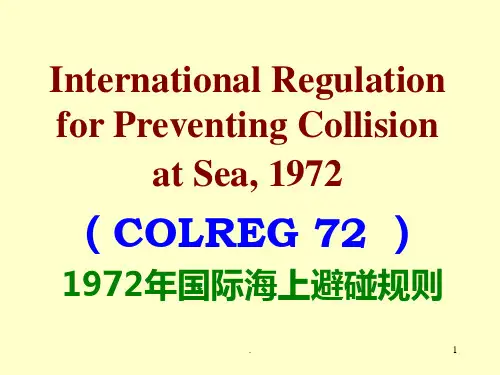
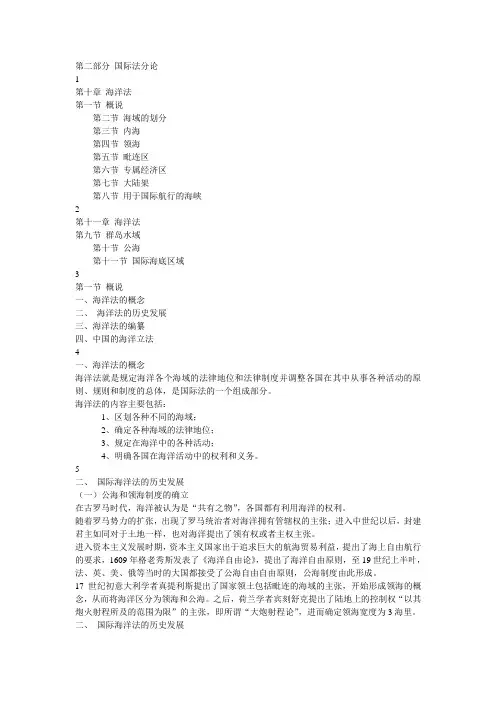
第二部分国际法分论1第十章海洋法第一节概说第二节海域的划分第三节内海第四节领海第五节毗连区第六节专属经济区第七节大陆架第八节用于国际航行的海峡2第十一章海洋法第九节群岛水域第十节公海第十一节国际海底区域3第一节概说一、海洋法的概念二、海洋法的历史发展三、海洋法的编纂四、中国的海洋立法4一、海洋法的概念海洋法就是规定海洋各个海域的法律地位和法律制度并调整各国在其中从事各种活动的原则、规则和制度的总体,是国际法的一个组成部分。
海洋法的内容主要包括:1、区划各种不同的海域;2、确定各种海域的法律地位;3、规定在海洋中的各种活动;4、明确各国在海洋活动中的权利和义务。
5二、国际海洋法的历史发展(一)公海和领海制度的确立在古罗马时代,海洋被认为是“共有之物”,各国都有利用海洋的权利。
随着罗马势力的扩张,出现了罗马统治者对海洋拥有管辖权的主张;进入中世纪以后,封建君主如同对于土地一样,也对海洋提出了领有权或者主权主张。
进入资本主义发展时期,资本主义国家出于追求巨大的航海贸易利益,提出了海上自由航行的要求,1609年格老秀斯发表了《海洋自由论》,提出了海洋自由原则,至19世纪上半叶,法、英、美、俄等当时的大国都接受了公海自由自由原则,公海制度由此形成。
17世纪初意大利学者真提利斯提出了国家领土包括毗连的海域的主张,开始形成领海的概念,从而将海洋区分为领海和公海。
之后,荷兰学者宾刻舒克提出了陆地上的控制权“以其炮火射程所及的范围为限”的主张,即所谓“大炮射程论”,进而确定领海宽度为3海里。
二、国际海洋法的历史发展至19世纪上半叶,在公海制度形成的同时,由沿海国对其沿岸一带狭窄海域行使主权的领海制度也逐渐得到了国际社会的普遍承认,直至20世纪中叶,国际海洋法一直把地球海洋基本上分成领海和公海两部分,因此,有“领海以外即公海”之说。
(二)大陆架和200海里海洋权制度的确立第二次大战结束以后,国际海洋法发生了革命性的变革:沿海国的管辖权不再局限于领海,而是扩展到了原先实行公海制度的广阔海域。
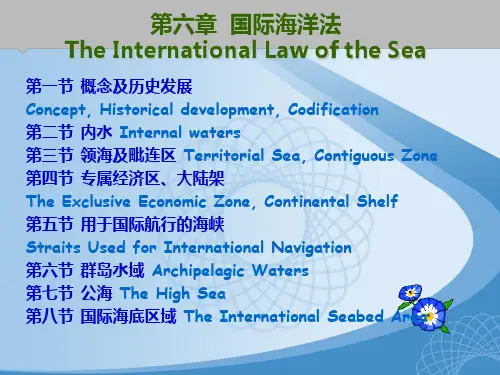
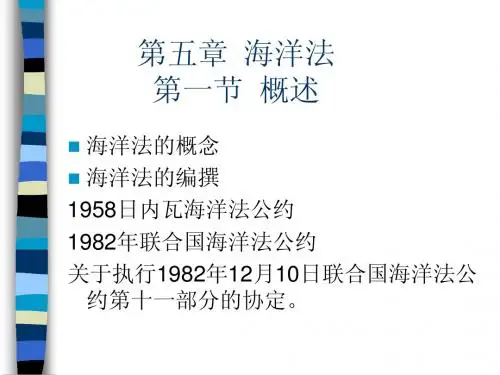
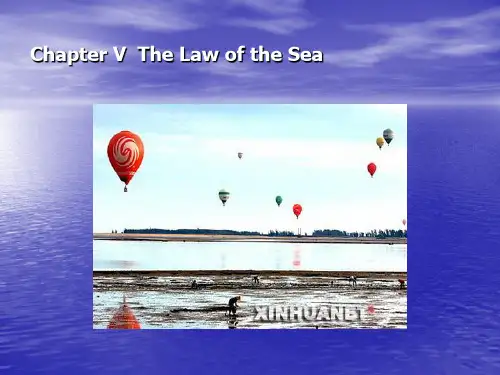
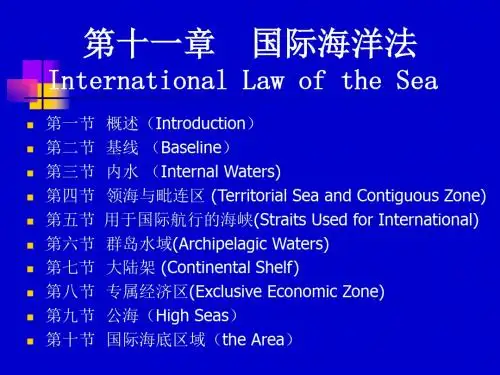
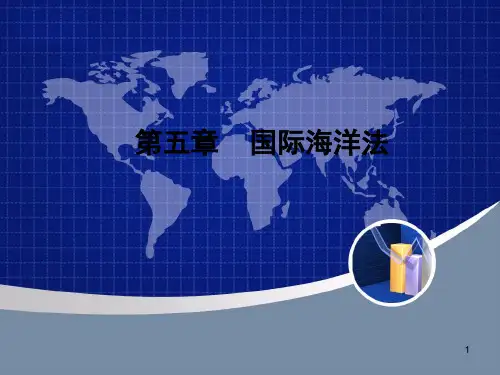

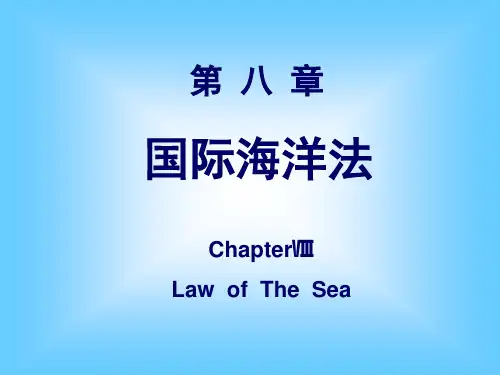

国际海洋法第一节概述一、国际海洋法的概念The law of the sea is that law by which States regulate their relations in respect of the marine territory subject to coastal State jurisdiction and those areas of the sea and sea bed beyond any national jurisdiction.三、国际海洋法的编纂Codification of International Law of the Searelevant conventions are:a) Convention on the Territorial sea and the Contiguous Zone 1959 [TSC],(entered into force on Sept. 10,1964); 领海与毗连区公约b) Convention on the Continental Shelf 1958[CSC], (Jun. 10,1964); 大陆架公约c) Convention on Fishing and the Conservation of the Living Resources of the HighSeas 1958[FC],(Mar. 20,1966);捕鱼和养护公海生物资源公约d) Convention on the High Seas 1958[HSC],(Sept. 30, 1962);公海公约ande) United Nations Convention on the law of the sea (Law of the Sea Convention )1982[LOSC],( Nov. 16, 1994)。
联合国海洋法公约四、领海基线baselines of the territorial seaThe starting point for establishing the maritime zones.The baselines of a state serve dual functions:They demarcat e the state’s internal waters from external waters. They also provide the lines from which the outer limits of maritime zones will be measured .Thus, all waters of a state that are landward of its baselines are internal waters and are an integral part of the territory of the coastal State, and are treated virtually as if they were part of the state’s land territory. Waters seaward of a state’s baselines are subject to the law of the sea.According to Law of the Sea Convention , there are two types of baselines:1. 正常基线normal baseline / natural baselineLOSC Article 5 “the normal baseline for measuring the breadth of the territorial sea is the low-water line along the coast as marked on large-scale charts officially recognized by the coastal State. ”测算领海宽度的正常基线是沿海国官方承认的大比例尺海图所标明的沿岸低潮线。
国际海洋法第一节概述一、国际海洋法的概念The law of the sea is that law by which States regulate their relations in respect of the marine territory subject to coastal State jurisdiction and those areas of the sea and sea bed beyond any national jurisdiction.三、国际海洋法的编纂Codification of International Law of the Searelevant conventions are:a) Convention on the Territorial sea and the Contiguous Zone 1959 [TSC],(entered into force on Sept. 10,1964); 领海与毗连区公约b) Convention on the Continental Shelf 1958[CSC], (Jun. 10,1964); 大陆架公约c) Convention on Fishing and the Conservation of the Living Resources of the HighSeas 1958[FC],(Mar. 20,1966);捕鱼和养护公海生物资源公约d) Convention on the High Seas 1958[HSC],(Sept. 30, 1962);公海公约ande) United Nations Convention on the law of the sea (Law of the Sea Convention )1982[LOSC],( Nov. 16, 1994)。
联合国海洋法公约四、领海基线baselines of the territorial seaThe starting point for establishing the maritime zones.The baselines of a state serve dual functions:They demarcat e the state’s internal waters from external waters. They alsoprovide the lines from which the outer limits of maritime zones will be measured .Thus, all waters of a state that are landward of its baselines are internal waters and are an integral part of the territory of the coastal State, and are treated virtually as if they were part of the state’s land territory. Waters seaward of a state’s baselines are subject to the law of the sea.According to Law of the Sea Convention , there are two types of baselines:1. 正常基线normal baseline / natural baselineLOSC Article 5 “the normal baseline for measuring the breadth of the territorial sea is the low-water line along the coast as marked on large-scale charts officially recognized by the coastal State. ”测算领海宽度的正常基线是沿海国官方承认的大比例尺海图所标明的沿岸低潮线。
”2. 直线基线Straight baselinesLOSC Article 7 (1)“In localities where the coastline is deeply indented and cut into, or if there is a fringe of islands along the coast in its immediate vicinity, the method of straight baselines joining appropriate points may be employed in drawing the baseline from which the breadth of the territorial sea is measured. ”在海岸线极为曲折的地方,或者如果紧接海岸有一系列岛屿,测算领海宽度的基线的划定可采用连接各适当点的直线基线法。
”第二节主要海域一、内海internal seaLOSC Article 8 (1) waters on the landward side of the baseline of the territorial sea form part of the internal waters of the State. ”领海基线向陆一面的水域构成国家内水的一部分legal status:1. coastal State has complete and exclusive sovereignty subject to the right offoreign vessels in distress to seek safety in internal waters2. Where the establishment of a straight baseline has the effect of enclosing asinternal waters areas which had not previously been considered as such, a right of innocent passage as provided in this Convention shall exist in those waters.二、领海the territorial sea1. 领海的概念Concept of territorial seaLOSC Article 2 (1) “The sovereignty of a coastal State extends, beyond its landterritory and internal waters and, in the case of an archipelagic State, its archipelagic waters, to an adjacent belt of sea, described as the territorial sea.”沿海国的主权及于其陆地领土及其内水以外邻接的一带海域,在群岛国的情形下则及于群岛水域以外邻接的一带海域,称为领海。
2. Breadth of the territorial sea 领海的宽度LOSC Article 3“Every State has the right to establish the breadth of its territorialsea up to a limit not exceeding 12 nautical miles, measured from baselines determined in accordance with this Convention.” 每一国家有权确定其领海的宽度,直至从按照本公约确定的基线量起不超过十二海里的界限为止。
(1) Interior limit of the territorial sea--- is baselines of the territorial sea, which is the boundary between internal watersand territorial sea.领海的内部界线----是领海基线,是内水和领海的分界线。
(2) Outer limit of the territorial seaLOSC Article 4The outer limit of the territorial sea is the line every point of which is at a distancefrom the nearest point of the baseline equal to the breadth of the territorial sea. 领海的外部界限----是一条其每一点同基线最近点的距离等于领海宽度的线。
3.领海的法律地位legal statusLOSC Article 2 (1)The sovereignty of a coastal State extends, beyond its landterritory and internal waters and, in the case of an archipelagic State, its archipelagic waters, to an adjacent belt of sea, described as the territorial sea.(1)沿海国的主权及于其陆地领土及其内水以外邻接的一带海域,在群岛国的情形下则及于群岛水域以外邻接的一带海域,称为领海。
(2)This sovereignty extends to the air space over the territorial sea as well as to Itsbed and subsoil.(2)此项主权及于领海的上空及其海床和底土。
(3)The sovereignty over the territorial sea is exercised subject to this Convention andto other rules of international law. (3)对于领海的主权的行使受本公约和其他国际法规则的限制。